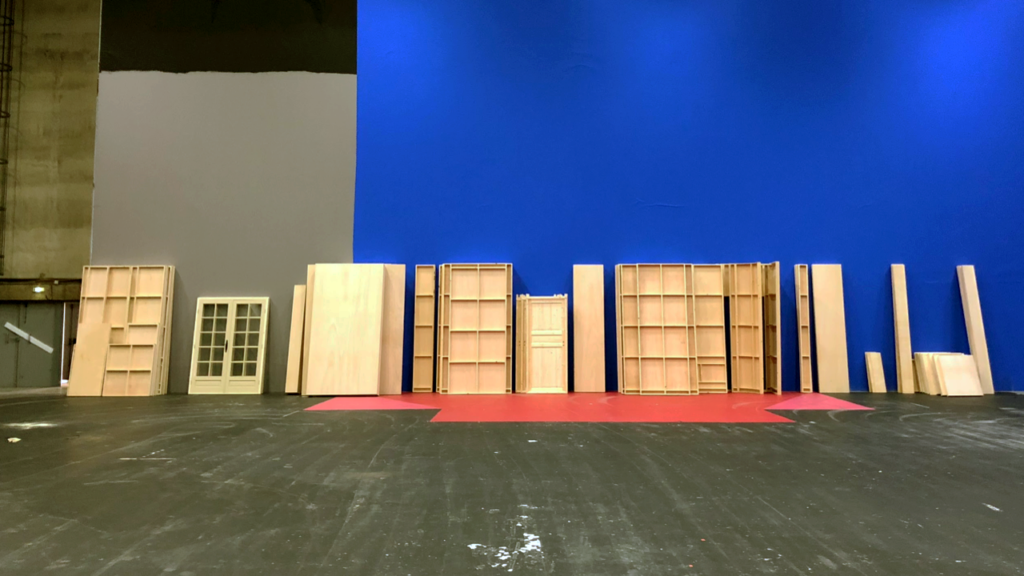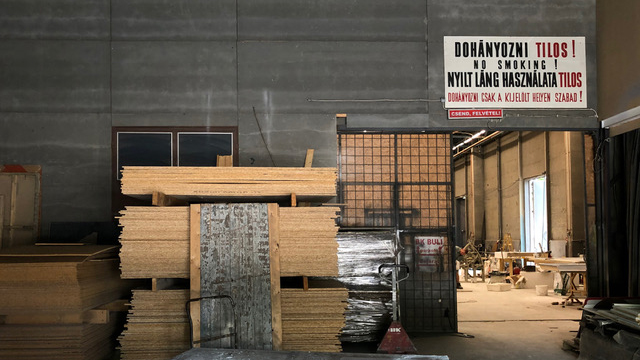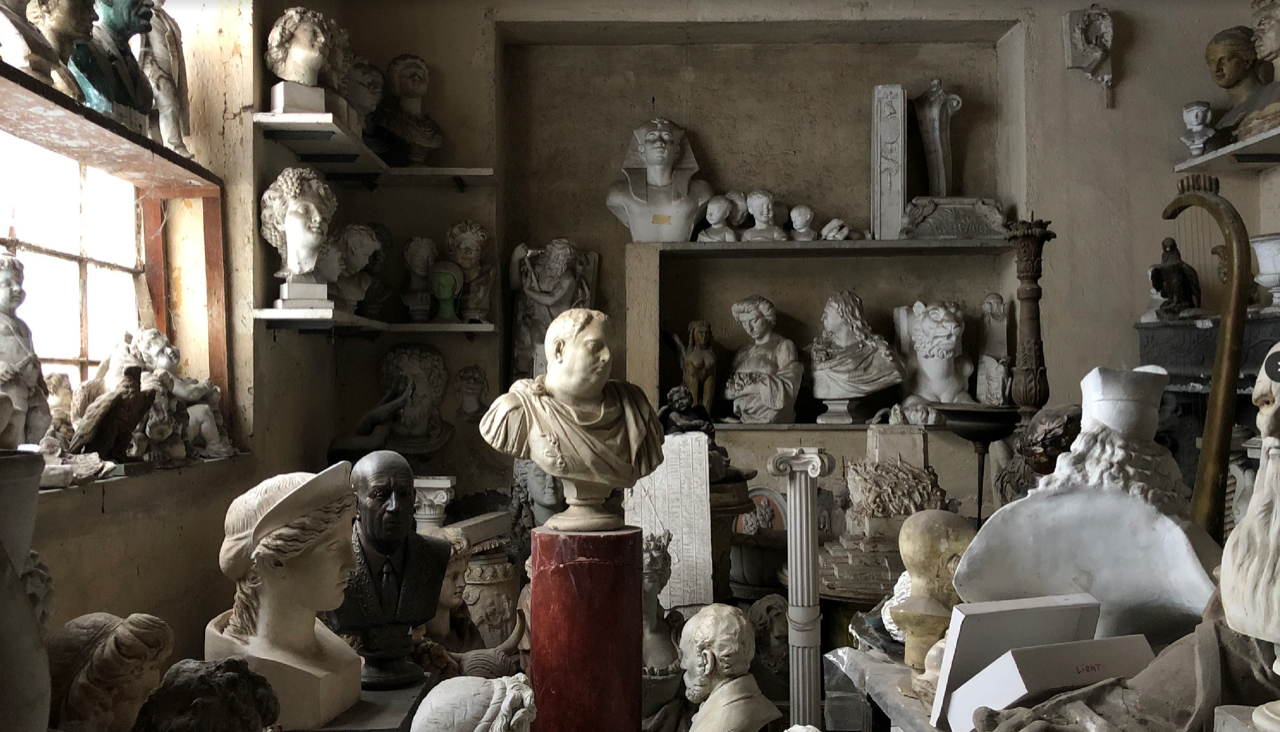“What does it take to compose an image?” is the central query for architect Aude-Line Dulière, winner of the 2018 Wheelwright Prize, regarding the temporary environments built for cinema. This question drives her recent work, which has focused on the flow of the material environment and supply chains within the global film industry. Since graduating from the GSD in 2009, Dulière has contributed to the field as an architect at David Chipperfield Architects in London, taught and researched with the Brussels based cooperative Rotor, and worked on film sets. She jumped at the chance to extend her reach with the grant and to speak with us about her recent travels.
“The grant was a wonderful facilitator to actually gain access to an inaccessible world,” Dulière says. The Wheelwright Prize, notable for its investigative approach to modern design, has a long history of helping young architects to expand their knowledge through intensive travel and cross-cultural platforms. For Dulière, this meant spending time on movie production sets in Paris, Budapest, Belgium, and Rome to explore the intersection of architecture and film.
The unmaking, the dismantling, the breakdown is not often considered in the realm of art. There is not the idea of the art of unmaking. Everyone wants to build, to create, but careful deconstruction is becoming more meaningful, as well.
On how deconstruction and cataloging that could provide long-term financial and ecological benefits to the global film industry
It is an industry that has delighted architects for decades through its simultaneous use of advanced technology and traditional building craftsmanship—digital manipulation in tandem with hand-worked material. The fast-paced nature of the film circuit, with its capacity to create a set, film a movie, and break down the set immediately after, multiple times a year, allows for constant innovation. Dulière explains, “With architecture you have to wait five years to see something built, but in the movie industry it can come together in six months.” It is within these speedy construction zones that Dulière finds promise. “The industry has the potential to be a pioneer in better practice because it moves so quickly. It’s a fast cycle of making and unmaking. It’s very exposed. It’s global. It’s a culture industry. It’s very fertile ground for the dissemination of new practices” she says.
Dulière spent months planning: sorting out contacts, talking to movie guilds in half a dozen countries, and arranging access to an insular world notably protective of its practice. As a major cultural industry, film sets are notoriously impenetrable due to copyright laws and protections of intellectual property. “It’s hard to get invited onto a movie set if you are not formally employed or working for them,” Dulière said. “I’m coming on with a new set of ideas, researching, and observing from the workshop to the offices, envisioning the future of the industry.” After spending six months on public relations to lay the groundwork for research, Dulière’s hard work was rewarded.

She flew to Rome to shadow on a movie production site. To root her research in the raw material, Dulière likes to start an initial inquiry with a substance used on set. “My strategy is to find a sort of trigger, a thread to pull,” she says. “It could be, for example, fiberglass. I will start with fiberglass and I will explore how it is being used, and then find which companies are producing fiberglass, and find which are actually recycling the material, and then find where it’s being stored and how, and pull, pull, pull, until I find the end.” She’s untangling the supply chain from source to demolition.
“It is amazing what they can achieve with fiberglass,” she says. “On some sets they’re making fake stone with it. It looks exactly like stone; it’s only when it’s backlit or when the sun shines through the material that you can tell it’s fabricated. Fiberglass is, however, a very problematic material because there is no obvious recycling route—it mostly goes straight into landfills. In the case of boats, for example, there are hulls being sunk under the sea to avoid paying for waste management. This is sort of the end of the thread—finding out where and how the material is disposed of, and how much it costs to throw away.”
This was a major insight for Dulière: the construction budget does not always follow all the way through to disposal. And for an industry like film with a lot of moving parts and parameters, the bottom line is usually the guiding force. “Some production houses, for example, will buy medium density fiberboard over plywood, because MDF is slightly cheaper, but because of its large glue content it is highly polluting, which means it is more expensive to dispose of. But because building budgets are not taking into account waste management since that labor is normally outsourced, they end up paying more in the long run.” Clearly, a valuable insight.
Obtaining access to the studio workshops and those actually handling and shaping the material is essential for Dulière. She has found beauty in the recent craftmanship she has seen. “I’ve really been impressed with the plaster work!” she says. “I was on a set where the plaster masters were working with their own tools that they themselves had made to construct a curved element. It was something you’d think would be done by a machine or robot but here was this highly traditional workmanship.”

Though the built settings for movies are only meant to be temporary environments, the industry maintains a reserve of skilled workers with technical expertise. Dulière explains, “It’s a strange field: I’ve found that film is a surprising repository of some crafts that have completely disappeared from architecture. The unions have protected the labor and craft, and have allowed them to flourish, so you have early-20th-century skill working in tandem with highly digitized technology.” This dichotomy, and the tension between the two, makes film production sets a unique space for thinkers like Dulière.
The industry is very focused on making, creating, and building for the sake of the image. What it lacks, Dulière argues, is a little more equilibrium in deconstruction and cataloging that could provide long-term benefits that are both financial and ecological. “The unmaking, the dismantling, the breakdown is not often considered in the realm of art. There is not the idea of the art of unmaking. Everyone wants to build, to create, but careful deconstruction is becoming more meaningful, as well” she says.
Dulière’s travels and case studies have generated a number of dynamic strategies for a more holistic future of the industry’s ecosystem. There is room for renovation and more awareness—such as developing a library of useable materials, fortifying links between various like-minded builders and recyclers, and establishing frameworks of operations that would allow for the strategic reuse of some materials.
“To either reuse within the industry, which offers a lot of potential, or a cross-industrial reuse, which is also exciting, that is something that already exists to some extent but should be celebrated much more,” she explains. “Parts of sets can integrate into others or be repurposed. Reuse is not a new idea: if we rewind to early moviemaking days, they used flats—flats are the walls of sets. They would have a sort of library of sets and store them and they would be able to reuse them.”
Dulière has presented some of her early findings at the Academy of Sciences at the Vatican. She’ll be looking for alternatives to polystyrene with a company based in Brighton that has experimented with sculpting cork, and there is a Ridley Scott Production on which she is aiming to assist. Overall, she has come away with a more comprehensive understanding of the European film industry ecosystem and a renewed excitement about how all of the complex moving parts come together to create something physical. “The beauty, the energy, the intensity of the industry. There is a lot of joy here,” she explains.
“My aim is not only to learn, but to support and to contribute where I can, with perhaps policy proposals, bringing new tools to the table, or facilitating a new practice.” Though it would seem as though she is at the tail end of the experience, Dulière disagrees: “Well, no, I wouldn’t say that, absolutely not, for me, it’s really only beginning.”
